What is anorexia nervosa?
A psychological disorder characterised by self-starvation , very often excessive exercise, and weight loss. Anorexia nervosa is subcategorised into 2 types:1. Restrictive (starvation)
2. Purging (including bingeing and purging or excessive exercise).
Though it has psychological origins, it also obviously affects physical wellbeing.
The condition usually begins with a desire to diet and lose weight. It may be triggered by an event affecting the person mentally such as the end of a relationship or the death of some loved ones. Almost 60% of patients suffering from anorexia nervosa have been sexually abused. Anorexic person dislike food and are terrified by the thought of that they may gain weight. They eventually do not eat enough to maintain a healthy body weight. Anorexic persons think themselves to be overweight. In reality they are thin or underweight.
Anorexic people may behave differently, they refuse to eat in front of other people. Some may be greatly interested in the preparing and cooking of food but not in eating. They may also avoid entire food groups, especially those considered high in fat or carbohydrates. Anorexic people engage themselves in excessive exercise patterns to reduce weight. They use appetite suppressants to curb appetite.
People with anorexia nervosa will usually not accept that there is something wrong with their eating pattern. Anorexia is an addictive state. It acts just as alcohol and drugs do in the chemical addict, and once they start dieting and losing weight, it is very difficult for them to stop. The disorder may lead to various medical complications. It is potentially very dangerous and if not treated appropriately, it may result in death of the individual.
Causes for Anorexia nervosa
The factors that lead to the disorder are complex and not clearly understood.1. Psychological, social, biological, cultural and familial factors all play a role in the development of the disorder.
2. It has recently been found that it has also got a genetic or organic basis.
3. Young women want them to be as models who are always slim and often waif-like.
4. Anorexia nervosa starts when a young person is going through a difficult life stage.
5. High risk age for developing the disorder is 16-24 years.
6. Anorexics often have a poor self-image and believe they don’t deserve love and is coupled with a pressure to be thin and attractive.
Symptoms for Anorexia nervosa
The following symptoms are present in confirmed cases of anorexia nervosa:• Do not maintain ideal body weight for their age and height
• Fear of gaining weight or becoming obese, even though underweight
• A distorted body image
• Irregular menstrual cycles
• Vomiting
• Use of appetite suppressants
• Strict rules about eating
• Obsessive compulsive disorder
• Excessive exercise
• Lack of sexual desire
• Feel tired of day-to-day functioning
• Wearing bulky and concealing clothing to hide their thin personality
Anorexia can have a serious impact on the individual’s life. Starvation can lead to depression. The individual always feels tired, suffer from decreased attention and concentration and may lose interest in their daily activities.
Medical complications related to starvation may include:
• Low heart rate
• Dry skin
• Excessive energy
• Cold intolerance
• Low blood pressure
• Gastrointestinal problems such as constipation and abdominal pain
• Hormonal disturbances
• Swelling of joints
• Brittleness of hair and nails
• Irregular heart rate
• Impaired kidney functioning
• Anaemia
• Severely low blood pressure
• Erosion of dental enamel because of repeated vomiting
• Brittleness of bones (osteoporosis)






0 Comments